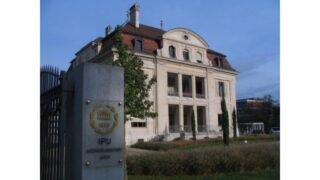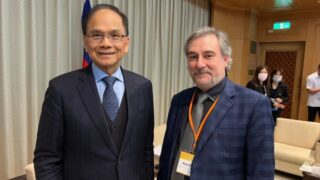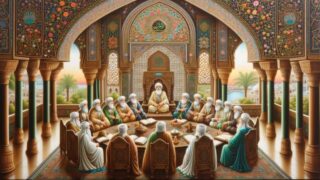The Belle Époque attempts to build a grandiose Peace Palace hosting a world government failed. Tai Ji Men teaches that the real Peace Palace is inside us.
by Massimo Introvigne*
*A reflection on U.N. United Nations Day, October 24, 2023.


We all know that, before the United Nations, there was the League of Nations, established in 1920 and headquartered in Geneva, Switzerland. Less well-known is that before the League of Nations there was the Foundation for Internationalism, founded in 1905. And the Foundation had deep ties with a new spiritual movement, the Theosophical Society, established in 1875.
One of the Theosophical Society’s main tenets was the idea of a “universal brotherhood” of all human beings, which explains its efforts for a lasting world peace. Pieter Eijkman was a Dutch medical doctor with a lifelong interest in Theosophy. He was inspired by the foundation in The Hague, the Netherlands’ capital, in 1899, of the Permanent Court of Arbitration, whose purpose was to avoid wars by having disputes between states decided by independent arbitrators, to launch in 1905 the broader project of the Foundation for Internationalism. Its aim was to have all nations recognize the authority of a series of institutions aimed at creating a world government, which would have been headquartered in a “Peace Palace” to be built in a city designated as the “world capital.” Since The Hague already hosted the Permanent Court of Arbitration, Eijkman regarded as logical that the world capital should also be located in the Netherlands.
From its beginnings, the project of the world capital and the Peace Palace was artistic and spiritual as much as it was political. It would not have attracted several intellectuals and artists, including sculptor Auguste Rodin, if the Netherlands had not hosted a number of prominent architects who were Theosophists. They had established in 1896 a lodge of the Theosophical Society called Vahana consisting mostly of architects. One of them, Karel de Bazel, designed the plan of the world capital, to be built north of The Hague, with eight majestic avenues converging on the Peace Palace, whose symbols were distinctly Theosophical. The project would cost millions, but Eijkman and de Bazel told the Dutch government that British-American billionaire Andrew Carnegie, who was interested in the idea of a world government, would finance half of it.


The campaign gathered significant support but ultimately failed for two main reasons. One was that a strong movement in nearby Belgium argued that the world capital should be built in Brussels rather than The Hague. Its main proponent, Paul Otlet, was (probably) not a member of the Theosophical Society but was a close associate of Belgium’s most prominent Theosophist, painter Jean Delville. The latter invited Otlet to present his project at international gatherings of the Theosophical Society. There, the campaign for a world capital became somewhat connected with the idea that a young Indian Theosophist, Jiddu Krishnamurti, would soon reveal himself as the World Teacher.


Ultimately Krishnamurti refused this role, but this would happen only in 1929 and was not the reason why the campaigns for a world capital and a world government came to an end in 1912. The Foundation for Internationalism was disbanded, and Carnegie limited himself to finance a majestic seat for The Hague’s Permanent Court of Arbitration. Beyond the competition between The Hague and Brussels within the same Theosophical circles, the problem was precisely the adoption of symbols and the jargon of the Theosophical Society, an organization then actively engaged in arguing the superiority of Eastern religions over Christianity. This could not fail to generate a Christian reaction and opposition. Conservative Swiss Catholic writer Gonzague de Reynold emerged as the most vocal critic of what he called a Theosophical “Church against the Church” in the making.
Although Theosophy insists it is not a religion, the League of the Nations and then the United Nations learned the lesson. They affirmed freedom of religion or belief as a key human right without embracing the cultural style of any specific spiritual organization. However the Foundation for Internationalism remains an important, if almost forgotten, part of the path leading to the United Nations. It also confirms the role that the early Theosophical idea of universal brotherhood played in this long path.
It is an idea also promoted by Tai Ji Men and its leader, Dr. Hong Tao-Tze. He teaches that we are all brothers and sisters and by getting in touch with conscience as our moral compass we can all perceive and affirm this universal brotherhood. There is no physical Peace Palace or heavenly city on Earth among Tai Ji Men. However, we can see in the Bell of World Peace and Love that world leaders are invited to ring a microcosm of a city of peace and a heavenly palace of love.


Those who participated earlier this month in the beautiful series of events Tai Ji Men organized in California in connection with the opening of two new Tai Ji Men Qigong Academies in Santa Clara and Pasadena surely understood a key point. There are Tai Ji Men academies and, in addition to teaching qigong, they are centers of irradiation of its message of peace, love, and conscience. Ultimately, however, for Tai Ji Men the Peace Palace is not a material building. It lives in the hearts of all dizi (disciples) united with their Shifu (Grand Master) and welcomes all those who sincerely seek peace and love. It is also the place where Tai Ji Me dizi find inner peace overcoming harassment and persecution, and awaiting the day when justice will be restored to them. It is into this spiritual Peace Palace that Dr. Hong invites all men and women of good will and pure heart to enter.









